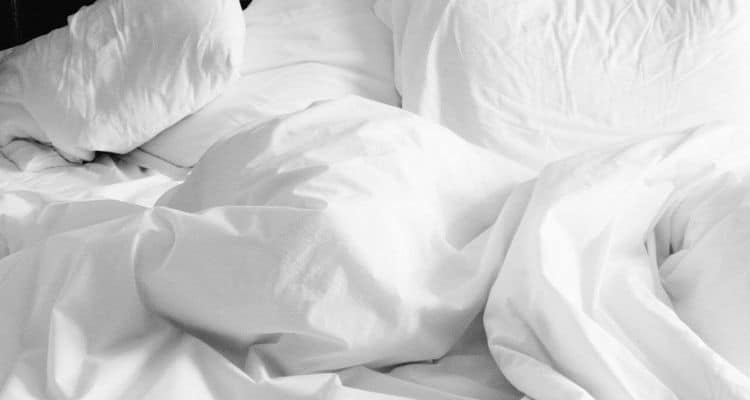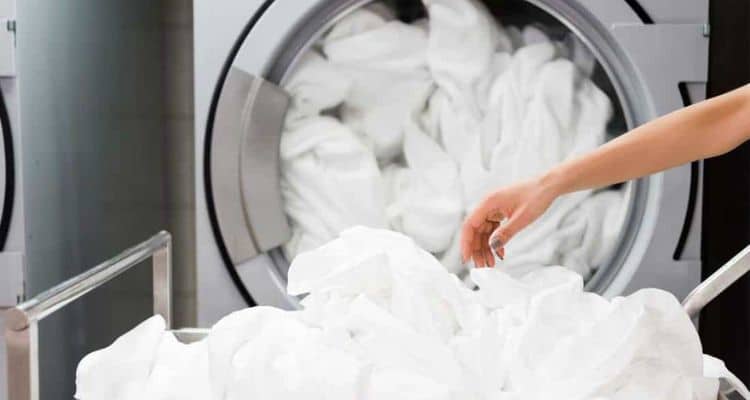The crispiness of a fresh and clean bed sheet is something we all want for our sleep. Cleaned white sheets are the dream of every sleeper since they can make your room look neat and organized. They contribute to healthy and long-lasting sleep. But those messy stains can become a real hurdle to that.
We don’t often clean our bed sheets which makes them a real mess, and that’s where they spoil our peace of the night. Therefore, something needs to be done about those dingy yellow-colored bed sheets if you want your sheets to feel nice and cozy again.
Let’s learn how to clean your messy bed sheets to bring back that hotel-quality spark out of them (also check 7 top rated hotel style sheets).
What Are the Different Methods to Clean White Sheets?
White sheets catch those yellowish stains and make them evident. Your body sweats and oil released during sleep, along with lotions and skin care products, all contribute to these messy stains. As a result, cleaning them with ordinary laundry methods and ingredients becomes difficult. If you don’t clean them frequently, you may even need to buy a new one.

So, you would need to do something out of the usual to bring back their original grace and looks. Follow the steps below to wash them thoroughly. It only requires some household ingredients and items and regular detergent use.
Borax
Using Borax can effectively remove those yellowish stains from your sheets. This powdery mineral can work as a laundry booster whitener. Luckily, it’s easily available in most grocery stores. Add a half cup into a gallon of water and presoak the sheets.
Leave it presoaked for the whole night so it can completely soak up into the sheets. This prolonged exposure of Borax with sheets will remove that entire yellowish tinge. Later, you can wash them with your normal daily use of mild detergent.
Vinegar
Before washing the white sheets, add Vinegar and pre-soak the sheets for effective clean results. Use a big tub or tub and mix a water gallon with one cup of Vinegar in it. Soak the sheets in this solution for at least an hour.
Later wash them gently in the machine or with your hands and air dry them if you feel like removing their smell.
Baking Soda
Baking soda can work as an effective and safe ingredient to wash many clothes if used correctly. It helps to neutralize the odor and bring back that whitening look instantly.
All you need is to mix a baking soda cup into your mild detergent before wash. It will boost the cleaning power of washing detergent to give your sheets a brightening white look without smell.
Lemon Juice
Lemons effectively bring back that lost bright look to your sheets. Citric acids are present in work as a bleaching agent. Add one piece of lemon juice of one full lemon in the machine while washing the sheets, and it will work as a whitening agent. In addition, the citrusy smell of lemons will eliminate the vinegar smell if you soak your sheets in nightly.
Bleach
Bleach works best for whitening any cloth because it has chlorine. However, using bleach can be different compared to other ingredients. It’s because bleach’s effect is the opposite if you use it in a straight way for whitening purposes.
So, first, you need to wash the white sheets with mild detergent to remove their body oils and sweat traces. Next, add a half cup of bleach and wash them for whitening results.
Bluing It
It can eliminate the yellowish shade of your sheets for getting their bright white look back once again. However, their effect diminishes after every wash. They are easily available at most grocery and hardware stores.
Instead of adding it directly to the sheets, you should dilute it in cold water. Carefully read the instructions about diluting them on the liquid bluing label, as the instructions may vary from brand to brand.
Usually, it takes one-fourth of the liquid, bluing in a teaspoon and mixes it in one-liter water. Pour this solution on your sheets with a normal wash cycle of washing detergent. Stir only 1/8 teaspoon of the liquid bluing if you use it with the rinse cycle option.
Don’t use liquid bluing with your washing machine’s automatic dispenser; it can leave bluing stains. Avoid using fabric softeners or bleach with liquid except for the washing detergent. It may catch more stains if liquid bluing reacts with other laundry items.
Line Drying
Try hanging the sheets on the clothesline. The sunlight works as a bleaching agent for whitening the sheets. However, don’t leave them in the open air for about two or three hours. It can harm the cloth fabric instead due to excess heat.
Useful Tips for Maintaining Your White Beddings
Once you have whitened your bed sheets again, you will want them to retain their clean and whitening looks. You can use different ways to whiten the sheets after every wash to support them overall. Follow the tips below to prevent the sheets from losing their newly formed good condition.
Frequently Wash the Sheets
Despite taking a shower at bedtime, hair, body oils, and dead skin cells are still left behind on your bed. The gathered moisture, oil, and debris attract allergens in the form of mold, dust mites, bacteria, and fungi attached to the bed’s mattress. They all can start you sneezing, sore throat, running nose, breathing difficulties, and skin irritation causing sleep interruptions.
To avoid disrupting sleep, you must wash the sheets at least once a week. However, you should clean them more frequently if they are white-colored sheets. Try washing them after every four or five days, so they don’t lose their sparkling looks for a while. Use a different rinse cycle for your machine to remove the detergent completely.

These residues can discolor your sheets and can give your sheets a shabby look. Also, keep an eye out for the amount of detergent you use. Refrain from using an excess detergent for the sheets as it would leave residue, an extra burden of further cleaning. So, follow the detergent box instructions to know the required amount for the wash.
Don’t Use Any Softener
Avoid using fabric softeners, although they make sheets smell pleasant and comfortable. But they are also bad when it comes to rinsing them. As a result, they start building different chemicals on your sheet’s fabric. This will further prevent proper cleaning during the next cycle.
Therefore, to avoid this chemical build-up issue, try using vinegar instead. Considering their size, use a half or full cup of white vinegar, but in distilled form, inside the softener tray of your machine. Vinegar is an excellent alternative to fabric softeners that can otherwise damage the fabric of the sheets.
Washing Them Separately
White sheets always need extra care apart from catching those yellow-looking smelling stains. It would be best to avoid laundering white sheets with other colorful clothes.
Doing so will leave your white sheet at the mercy of its colors bleeding and mixing up, which can leave a colored stain. Therefore, to avoid color catching, always wash colored clothes separately from white bedding accessories or clothes.
You may be able to clean different types of stains from white. Removing white sheets can become difficult or nearly impossible if white sheets catch those colors.
Bedtime Face Washing
Face washing at bedtime can cause dust mites, dirt, and make-up stains on your sheet since we go out to different places and gather too much dirt on our faces. However, we don’t feel like catching it then and may not even feel them through the rest of the day.
But, at bedtime, all that stuck to your face can transmit to your white sheets. These stains will become more evident over time. Therefore, if you don’t wash your face right at bedtime, you might have to clean the sheets more often.
Avoid Eating At Bedtime
Eating at bedtime isn’t a healthy habit apart from causing stains on your lovely white brightening sheet. Regardless of how careful you may try to be, there is still a chance of spilling or dropping food or drinks on your bed sheets.
We all love sipping tea and coffee at bedtime; if spilled by mistake, these stains are quite hard to remove. Therefore, abstain from bringing any food at bedtime for the sake of your sheets. Especially if spilled on your mattress, they will become even more messy and difficult to remove.
How Can You Clean Your Discolored White Sheets?
Vinegar with Baking soda, both when used separately, can help at bringing back the brightening white look to your sheets. First, take a half cup of baking soda; add it to the drum of your washing machine.
Next, add distilled vinegar to the fabric softener container of your machine. Mixing them before using them might not be as helpful as adopting this separate-use technique.
Their separate use will give them the liberty to show their magic without interfering with each other, as the vinegar will get separated later in the fabric softener’s cup cycle. The results at the end of the cycle wash will make your sheet only look brightening white but also soft and comfortable at the same time.
Key Takeaways for Whitening Sheets
Root Cause of Yellowing
The common culprits behind the discoloration of white sheets are sweat, body oils, and remnants from skincare products.
Effective Cleaning Agents
Borax, Vinegar, Baking Soda, Lemon Juice, and Bleach are potent ingredients for battling yellow stains and restoring the white allure of your sheets.
Pre-soaking Ritual
Initiate the cleaning process with a pre-soaking routine, immersing sheets in a mixture of the selected agent and water, followed by a gentle wash.
Advanced Whitening Techniques
Bluing and Line Drying are advanced methods for tackling stubborn yellow tinges and achieving a brightening effect.
Maintaining Whiteness
Regular laundering, avoiding fabric softeners, and using protective covers can significantly prolong the whiteness and overall aesthetic appeal of your sheets.
Conclusion
White sheets are the pride of your bedroom, and they must retain their white and brightening look. They tend to become shabby no matter how much care you put in while using them. Therefore, cleaning them frequently by considering their safe wash procedure can help them maintain their graceful look.
You can use the above whitening options to give your sheets a new clean, brightening, crispy look. Wash, whitening, and properly rinsing them may last 4-5 years, subject to their fabric quality.
Resources:
https://www.washingtonpost.com/lifestyle/home/bleach-isnt-so-scary–if-you-know-how-to-use-it-correctly/2019/01/07/decb5514-0470-11e9-b5df-5d3874f1ac36_story.html
https://www.ncbi.nlm.nih.gov/pmc/articles/PMC9198988/
https://www.ncbi.nlm.nih.gov/pmc/articles/PMC6600116/
How to get white sheets white again FAQs
Can You Make Yellowed Sheets White Again?
Borax can effectively remove yellowish stains from them. Add a half glass into a water gallon and presoak the sheets. Leave it presoaked overnight so it can soak up into the sheets. This prolonged exposure of Borax with sheets will remove that entire yellowish tinge.
How Can I Get My Sheets White Again Without Using Bleach?
Water and Baking soda can make the sheet look white again. Combine one cup of baking soda with four liters of water and laundry your sheets into the mixture. It will make them feel clean and fresh like before.
Can Bleach Make The Sheet White Once Again?
Yes, you can use bleach to whiten your sheets but make sure not to use bleach on your unwashed sheets. Always use it on washed sheets; otherwise, body oils or sweat stains can make them messy instead of whitening the sheets.

